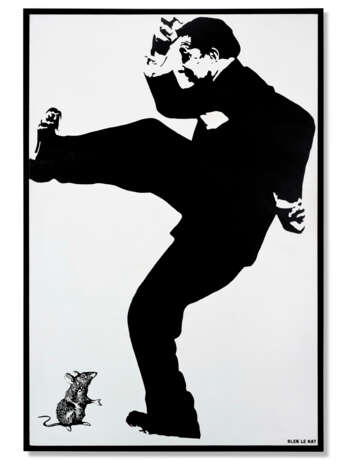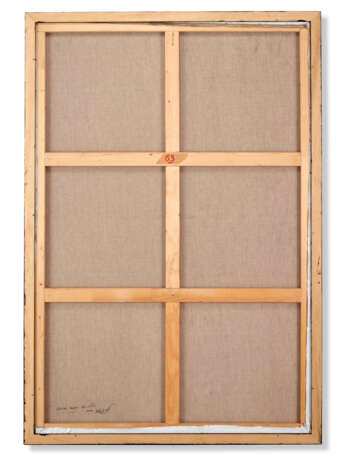ID 813910
Lot 40 | Blek le Rat (né en 1951)
Estimate value
€ 20 000 – 30 000
Getting through the wall
signé au pochoir 'BLEK LE RAT' (en bas à droite); signé, titré et daté 'BLEK LE RAT "GETTING THROUGH the wall" 2009' (au dos)
pochoir et peinture aérosol sur toile
195 x 130 cm.
Réalisé en 2009.
signed with stencil 'BLEK LE RAT' (lower right); signed, titled and dated 'BLEK LE RAT "GETTING THROUGH the wall" 2009' (on the reverse)
stencil and spraypaint on canvas
76 6⁄8 x 51 1/8 in.
Executed in 2009.
Special notice
Artist's Resale Right ("droit de Suite").
If the Artist's Resale Right Regulations 2006 apply to this lot, the buyer also agrees to pay us an amount equal to the resale royalty provided for in those Regulations, and we undertake to the buyer to pay such amount to the artist's collection agent.
This item will be transferred to an offsite warehouse after the sale. Please refer to department for information about storage charges and collection
details.
Post lot text
« J'ai pris conscience de mon pouvoir et de ma responsabilité en tant qu'artiste travaillant dans l'espace public ». - Blek le Rat
“I became aware of my power and responsibility as an artist working in the public space.“ - Blek le Rat
De son vrai nom Xavier Prou, Blek le Rat est né en 1951 à Paris et il est considéré comme le père du Stencil Movement (ou Mouvement du Pochoir) et du street art français. Marqué par sa découverte des premiers graffitis à New York lors d’un voyage en 1971, et par ce nouvel art épousant parfaitement l’architecture orthogonale de la ville, il se met à peindre dans les rues de Paris à partir de 1981. Ayant longuement étudié les techniques de gravures, de lithographie et de sérigraphie à l’École des Beaux-Arts de Paris, mais ayant également approfondi sa connaissance de l’architecture, afin de se sensibiliser aux « subtilités de l'espace urbain planifié », l’artiste réfléchit petit à petit à utiliser des pochoirs, qu’il trouve plus adaptés à l’architecture de Paris. Il affirme également avoir puisé son inspiration chez David Hockney : « C'est aussi au début des années 1970 que j'ai été largement influencé par David Hockney, qui a eu une grande exposition près de l'Ecole des Beaux-Arts à Paris. Je peux dire que son travail est la chose la plus impressionnante que j'aie jamais vue dans ma vie. L'année suivante, Hockney a réalisé un film intitulé The Bigger Splash, dans lequel il utilise de l'huile pour peindre l'image d'un de ses amis sur le mur d'un appartement ; cette image n'a jamais quitté mon esprit ».
Initialement, Xavier Prou ne travaillait pas seul et était accompagné de son ami Gérard. Le duo avait choisi le nom de « Blek », en référence à leur bande dessinée préférée, Blek le Rock. Toujours dans cette volonté de fondre leur art dans la capitale française, leurs premiers pochoirs représentent des petits rats noirs courant le long des murs. Délaissant totalement les graffitis urbains vus à New York pour se concentrer uniquement sur des pochoirs, tout en adoptant l’usage de la bombe de peinture, les deux artistes font du 14ème et du 18ème arrondissements leurs lieux d’expression favoris.
Choisissant le nom de « Blek le Rat » en 1983 à la séparation du duo, anagramme du mot « art », Xavier Prou invente par la suite le pochoir grandeur nature. Cette nouvelle forme d’art, il est le premier à la transformer, faisant ainsi évoluer de simples pochoirs de lettres en véritable art pictural. Blek le Rat se distingue alors petit à petit clairement des artistes new-yorkais, alors menés en tête de file par Keith Haring ou encore Jean-Michel Basquiat. À partir des années 2000, son art devient plus engagé et l’artiste n’hésite pas à faire passer des messages sociaux forts à destination de la population et des gouvernements dans les rues du monde entier, afin de faire sienne la responsabilité, dit-il, « en tant qu'artiste travaillant dans l'espace public ».
Blek le rat, whose real name is Xavier Prou, was born in Paris in 1951 and is considered as the father of the Stencil Movement and French street art. Marked by his discovery of the first graffiti in New York during a trip in 1971, and by this new art perfectly matching the orthogonal architecture of the city, he started to paint in the streets of Paris in 1981. Having studied engraving, lithography and silk-screening techniques at the École des Beaux-Arts in Paris, but also having deepened his knowledge of architecture, in order to become aware of the “subtleties of planned urban space,” the artist gradually began to think about using stencils, which he found more suited to Parisian architecture. He also claims to have drawn inspiration from David Hockney: “It was also in the early 1970's that I was greatly influenced by David Hockney, who had a big exhibition near the Ecole des Beaux-Arts. I can say that his work is the most impressive thing I have ever seen in my life. The following year, Hockney was featured in a film called The Bigger Splash, in which heuses oil to paint the image of a friend of his on the wall of a flat; that image never left my mind.”
Initially, Xavier Prou did not work alone and was accompanied by his friend Gérard. The duo chose the name “Blek” in reference to their favourite comic strip, Blek le Rock. Motivated by a strong desire to blend their art into the French capital, their first stencils represent small black rats running along the walls. Completely abandoning the urban graffiti seen in New York to focus solely on stencils, while adopting the use of spray paint, the two artists made the 14th and 18th arrondissements their favourite landmarks of expression.
Choosing the name “Blek le rat” in 1983 when the duo split up, an anagram of the word “art,” Xavier Prou subsequently invented the life-size stencil. He was the first to transform this new form of art from a simple stencil of letters to a real pictorial art. Blek le rat then gradually distinguished himself clearly from other New York artists, led at the time by Keith Haring and Jean-Michel Basquiat. From the 2000's onwards, his art became more committed and the artist did not hesitate to send strong social messages to the population and governments in the streets of the world, in order to take responsibility, he says: “as an artist working in the public space.”
| Art style: | Contemporary art |
|---|---|
| Place of origin: | Western Europe, France, Europe |
| Auction house category: | Paintings |
| Art style: | Contemporary art |
|---|---|
| Place of origin: | Western Europe, France, Europe |
| Auction house category: | Paintings |
| Address of auction |
CHRISTIE'S 9 Avenue Matignon 75008 Paris France | ||||||||||||||
|---|---|---|---|---|---|---|---|---|---|---|---|---|---|---|---|
| Preview |
| ||||||||||||||
| Phone | +33 (0)1 40 76 85 85 | ||||||||||||||
| Fax | +33 (0)1 40 76 85 86 | ||||||||||||||
| Conditions of purchase | Conditions of purchase | ||||||||||||||
| Shipping |
Postal service Courier service pickup by yourself | ||||||||||||||
| Payment methods |
Wire Transfer | ||||||||||||||
| Business hours | Business hours
|




